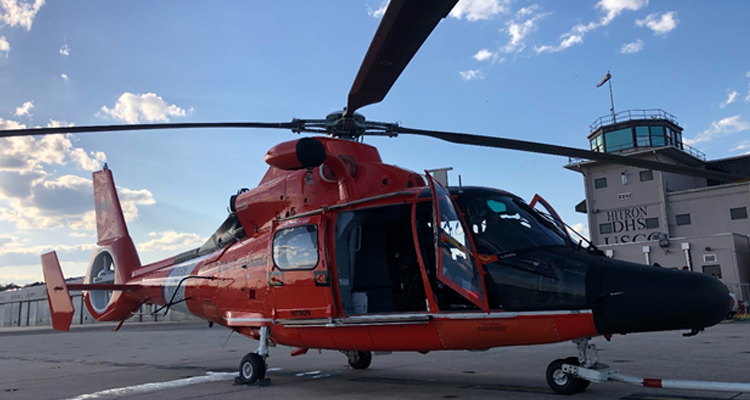April 26, 2022 —

CGNR 6555 is the last MH-65E to be delivered to Helicopter Interdiction Tactical Squadron, which holds the largest H-65 unit in the Coast Guard. U.S. Coast Guard photo.
The Coast Guard H-65 Conversion and Sustainment Program delivered CGNR 6555 to the Helicopter Interdiction Tactical Squadron (HITRON) April 4. With this delivery, 40 of 98 Dolphin short range recovery helicopters have been converted to the “E” configuration, and six facilities have transitioned to the upgraded aircraft.
HITRON’s primary mission of drug interdiction and combatting illegal, unreported and unregulated fishing is unique among the facilities receiving the upgraded aircraft. The upgraded MH-65E’s capabilities make for a safer, more reliable execution of HITRON’s missions.
“On a recent deployment utilizing the MH-65E, following the completion of warning shots on a go-fast vessel, the crew was able to remain on scene longer to provide boarding team cover to an arriving boarding team,” said Cmdr. Kent Reinhold, operations officer at HITRON. “Without the ability to be so precise with our fuel planning with the Common Avionics Architecture System (CAAS), this would have been much riskier. We were happy to be equipped with this new capability in the MH-65E.”
The avionics upgrade to the Echo or “E” configuration includes reliability and capability improvements for the automatic flight control system; enhanced digital weather/surface search radar; integration of a robust command, control, communications, computers, intelligence, surveillance and reconnaissance suite; and modernization of the digital flight deck. In addition to the upgraded search and rescue capabilities, the advanced navigation capabilities will allow pilots to safely maneuver through highly congested, complex air traffic that can be encountered in situations such as disaster response.
The updated CAAS, which provides a “significant upgrade in the ‘brains’ of the helicopter and how it interfaces with the pilots and aircrew,” is especially valuable to HITRON, Reinhold shared. “This new system greatly increases the accuracy of our fuel calculations, often providing a few extra vital minutes of on-scene time during the interdiction of a narco-trafficker. While three minutes doesn’t sound like a lot, it can make all the difference for the effectiveness of the interdiction. It also allows for increased safety for boarding teams.”
A CAAS cockpit also provides a longer-term benefit. The Coast Guard will be moving to an all MH-60T fleet in the future, and the MH-65E will prepare HITRON pilots for that transition, since CAAS is nearly identical to the equipment on the MH-60T. This will significantly reduce transition time and will allow the fleet to maintain mission readiness.
The transition from the MH-65D to the MH-65E has not come without its challenges, all of which the HITRON crew met head on.
“Change has its challenges, especially for a large 12-helicopter unit,” Reinhold said. “Over the last year, we have maintained a mix of MH-65D and MH-65E aircraft throughout the transition. This mix of people, qualifications and aircraft creates challenges to deployment scheduling as well as the scheduling of our daily training plan. Crews new to the MH-65E had to adapt quickly to establish a solid level of proficiency in the MH-65E prior to deploying. These challenges required our personnel to step up and meet the task, which they have done admirably.”
In conjunction with the upgrades, the Coast Guard is completing Service Life Extension Program activities on the Dolphin fleet to replace five major structure components: the nine-degree frame, canopy, center console floor assembly, floorboards and side panels. These mission-critical improvements are designed to extend the service life of the helicopter by 10,000 flight hours.
The Coast Guard is in the process of transitioning all its MH-65 facilities to the upgraded configuration; in addition to HITRON, Air Station Miami, Air Station Houston, Air Station Port Angeles, Washington, Sector North Bend, Oregon, and Air Station Barbers Point, Hawaii, have also transitioned from the MH-65D to the MH-65E. Sector Humboldt Bay, California, is the next in line to receive the upgraded aircraft. The Coast Guard plans to convert all 98 aircraft to the MH-65E configuration by the end of fiscal year 2024.
For more information: MH-65 Program page